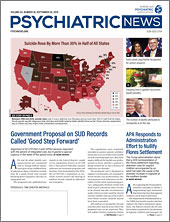A middle-aged woman, the sole provider for her daughter, is in the middle of divorce proceedings. Meanwhile, she is being hounded at work by a supervisor who has threatened to fire her. Embarrassed by her situation, she falls out of touch with friends. Worried that losing her job would mean losing custody of her child, she rarely sleeps. She ruminates uncontrollably about her predicament and feels cornered.
One afternoon she leaves work early to pick up her daughter from school. Rushing back to work, she crosses a busy street and sees a van approaching; rather than hurry out of the way, she freezes. The van brakes but strikes the woman.
Later, she tells her physician: I wanted to commit suicide; otherwise, I would have moved out of the way.
The vignette captures an essential feature of many suicides: the precipitous nature of a decision to die—a decision that may be made only in the minutes or hours before an attempt—and the almost complete lack of “suicidal ideation” until a crisis reaches its most acute phase.
Igor Galynker, M.D., Ph.D., said the woman in the vignette had all the symptoms of suicide crisis syndrome, a diagnosis he has proposed for inclusion in DSM to capture the acute state of mind in the period preceding a suicide attempt.
“She felt trapped at work,” he told Psychiatric News. “The boss was sadistic to her in the middle of divorce proceedings in which she feared she would lose custody of her daughter. She was in extreme emotional pain and did not believe she could escape the situation.
“The core feature of the SCS [suicide crisis syndrome] is this persistent and desperate feeling of frantic hopelessness or entrapment, an urgency to escape or avoid an unbearable life situation when escape is perceived as impossible,” he said.
Of the features of SCS, it is this perception of entrapment and emotional pain that may be most ripe for clinical intervention. “Entrapment and emotional pain may have a more direct association with suicidal intent than the other components of the SCS, which are mediated by the former,” Galynker said. “This suggests entrapment and emotional pain may represent key symptomatic targets for intervention in acutely suicidal individuals.”
Typical situations that may provoke SCS include terminal illness, a humiliating failure at work, or rejection by a romantic partner, according to Galynker. Crucially, suicidal ideation may or may not be present until moments before an attempt to die.
Because of the possible absence of suicidal ideation—other than in the most immediate moments before a suicide—health care professionals must rely on other features that identify the individual in crisis. In addition to the key feature of “frantic hopelessness or entrapment,” these include the following:
•
Loss of cognitive control: Intense and persistent ruminations about one’s own distress and the life events that brought it on; inability to deviate from a repetitive negative pattern of thought (cognitive rigidity), and repeated unsuccessful attempts to suppress negative or disturbing thoughts. This may be experienced somatically as a pain or pressure in the head from loss of control of one’s negative thoughts, impairing the ability to process information or make a decision.
•
Hyperarousal: Agitation or a state of extreme arousal, physical restlessness, hypervigilance, or heightened irritability, accompanied by insomnia.
•
Social withdrawal: Withdrawal from or reduction in scope of social activity and/or evasive communication with close others.
Galynker says clinicians assessing a patient who is in crisis may frequently sense something is “off” or amiss, not quite right, even in the absence of suicidal ideation. In this way, he said the SCS diagnosis empowers clinical judgment and frees clinicians from reliance on patients’ self-reports. At the same time, he says the features of SCS have been replicated in diverse populations and cultures. And they can be identified by a clinician-rated standardized checklist, developed by members of Galynker’s team at Mount Sinai and currently under review.
Galynker believes that it is time for clinical studies involving patients who meet criteria for SCS and—more importantly—for widespread education of health professionals, as well as the public, about the features of the SCS.
“We are describing a mental state that precedes a suicide attempt with a constellation of symptoms that are consistent and repeat themselves as a cluster to a very high degree,” he said.
“We are describing a mental state that precedes a suicide attempt with a constellation of symptoms that are consistent and repeat themselves as a cluster to a very high degree,” he said. ■

